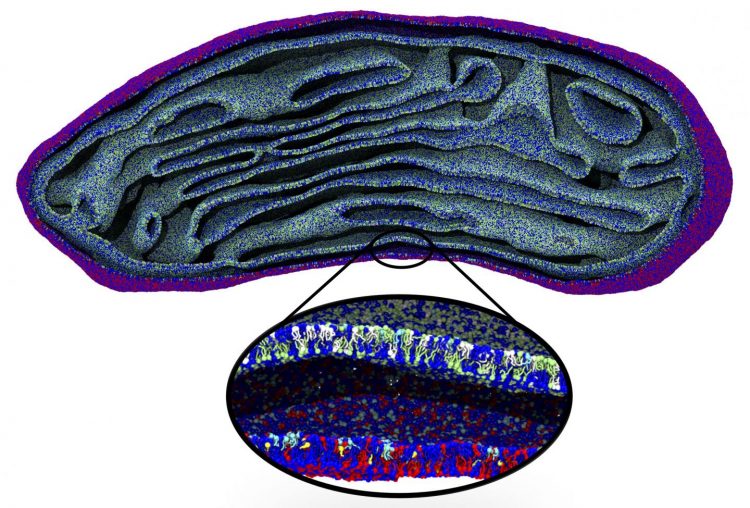First simulation of a full-sized mitochondrial membrane

Snapshot of the membranes of an entire organelle, a mitochondrion, simulated for the first time at molecular resolution. Credit: Marrink Lab, University of Groningen
Scientists from the University of Groningen have developed a method that combines different resolution levels in a computer simulation of biological membranes.
Their algorithm backmaps a large-scale model that includes features, such as membrane curvature, to its corresponding coarse-grained molecular model. This has allowed them to zoom in on toxin-induced membrane budding and to simulate a full-sized mitochondrial lipid membrane.
Their approach, which was published in the journal Nature Communications on 8 May, opens the way to whole-cell simulations at a molecular level.
Molecular dynamics simulations are a powerful tool to study the movements and interactions of atoms and molecules. However, in many biological processes, large-scale changes in, for example, membrane shape are important. 'These shape changes are of fundamental importance to the cell's functioning,' explains Siewert-Jan Marrink, Professor of Molecular Dynamics at the University of Groningen.
'However, the time and length scale of these membrane shape changes are too large for simulations at a molecular resolution.'
Challenging
Even though an increase in computing power allows more complex and longer simulations, cell structures such as mitochondria are still beyond reach. That is why the Molecular Dynamics group has developed an algorithm that links large-scale changes to molecular level simulations.
For mitochondria, they started with an electron micrograph density map. The densities were translated into lipid structures and these were used as the input for a molecular dynamics simulation with the Coarse Grain (CG) Martini force field, previously developed by Marrink.
'The difficult part is to place the lipids in the correct orientation in this density map, which is especially challenging in bent areas,' adds Wria Pezeshkian, a postdoctoral researcher in Marrink's team and co-author of the paper. The algorithm allows users to add different kinds of lipids to the membrane, at a realistic packing level.
Using this approach, Marrink and his colleagues were able to simulate the entire lipid membrane of a mitochondrion for two nanoseconds. Pezeshkian: 'This structure contained more than five million lipids, which meant that the simulation had to deal with 80 million particles as each lipid molecule consists of multiple particles.'
Triangles
Considering the size and shape, this simulation's complexity is larger than any simulation performed previously. 'A simulation of microseconds would have been possible but, as we had no information on the localization of the proteins in the mitochondrial membrane, it only contained lipids and is therefore unstable,' explains Marrink. Adding this extra complexity to the simulation is certainly possible and is currently in progress.
Instead of a density map, the input for the system could also be a continuum model, which represents the membrane surface as triangles made up of nodes that are connected by 'springs'. Such a model can calculate forces generated by membrane deformation. Backmapping lipids and toxin proteins onto the corresponding parts of this model allowed Marrink and his colleagues to zoom in on molecular behaviour in the stalk of a membrane bud that was induced by the joint action of many toxins.
Synthetic cell
'Our final goal is to simulate an entire eukaryotic cell and zoom in on specific parts of this object,' says Marrink. This is currently out of reach, although the current system already allows simulation of large objects inside a cell, such as the endoplasmic reticulum or the Golgi apparatus. 'And we could probably simulate a red blood cell.'
A simple synthetic cell may soon be within reach. Marrink is involved in a project aimed at creating a synthetic cell and being able to simulate processes such as cell division would help its design. 'We would really like to know which lipids and proteins could play a role in cell constriction during division.'
###
Simple Science Summary
Scientists use computer simulations to study the interaction of molecules in cells. However, many interactions are affected by processes on a time and length scale that is beyond the current limits for molecular simulations. Scientists from the University of Groningen have therefore developed a system where they use input from either density maps or large-scale models and zoom in on selected parts. These are then studied using detailed simulations at a molecular level. Using this technique, they successfully simulated the entire membrane of a mitochondrion, a large organelle inside cells. This technique enables the simulation of a variety of cell organelles and is a stepping stone towards simulations of entire cells.
Reference: Weria Pezeshkian, Melanie König, Tsjerk A. Wassenaar and Siewert J. Marrink: Backmapping triangulated surfaces to coarse-grained membrane models. Nature Communications, 8 May 2020
Media Contact
More Information:
http://dx.doi.org/10.1038/s41467-020-16094-yAll latest news from the category: Life Sciences and Chemistry
Articles and reports from the Life Sciences and chemistry area deal with applied and basic research into modern biology, chemistry and human medicine.
Valuable information can be found on a range of life sciences fields including bacteriology, biochemistry, bionics, bioinformatics, biophysics, biotechnology, genetics, geobotany, human biology, marine biology, microbiology, molecular biology, cellular biology, zoology, bioinorganic chemistry, microchemistry and environmental chemistry.
Newest articles

How marine worms regenerate lost body parts
The return of cells to a stem cell-like state as the key to regeneration. Many living organisms are able to regenerate damaged or lost tissue, but why some are particularly…

Nano-scale molecular detective
New on-chip device uses exotic light rays in 2D material to detect molecules. Researchers have developed a highly sensitive detector for identifying molecules via their infrared vibrational “fingerprint”. Published in Nature…

Novel CAR T-cell therapy
… demonstrates efficacy and safety in preclinical models of HER2-positive solid tumors. The p95HER2 protein is found expressed in one third of HER2+ tumors, which represent 4% of all tumors….



